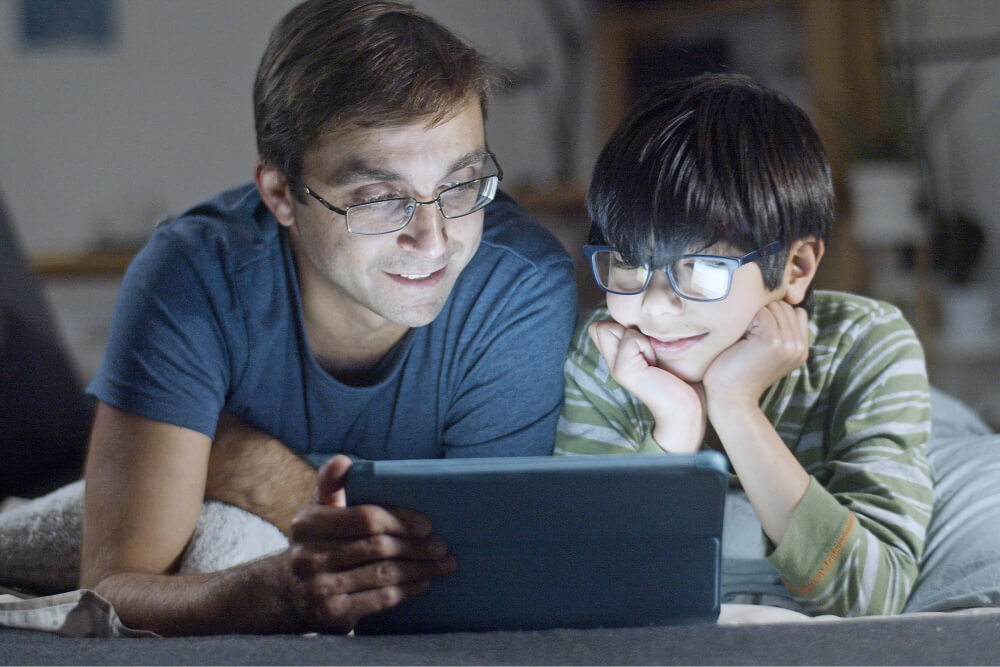Key Points
- The definition of screen time for kids in the guidelines includes TV, electronic gaming, computers, tablets and smartphones.
- Sufficient physical activity and sleep combined with limited screen time may be beneficial for a child’s social-cognitive development.
- Research is increasingly showing that there can be benefits to screen time for kids. It’s all about balance, how you use the screens and the content your kids are consuming.
- Choose apps, games or videos that encourage physical activity. E.g. Just Dance or Cosmic Yoga YouTube videos. Look into educational apps that are designed to help children learn.
On this page
How much screen time should my child have?
Screen time Guidelines in Australia
What does screen time do to a child's brain?
Setting screen time limits for children
Positive screen time ideas for toddlers and preschoolers
Supporting parents on the journey
How much screen time should my child have?
It’s one of those subjects that parents are so divided over. How much screen time should kids have? Should they have any screen time at all?
Given how much we rely on them today, it seems crazy to think that the first iPhone was only launched in 2007. No other generation of parents has had to navigate the issue of screen time for children in quite the same way so be kind to yourself!
Thankfully, this isn’t something you have to navigate on your own. We’ve pulled together a range of screen time recommendations and research that can help you make the decisions you need for your family.

Screen time guidelines in Australia
Interestingly, the Australian screen time guidelines form part of the physical activity and exercise guidelines for all Australians. They are part of a holistic approach to ensure kids get enough physical activity and sleep each day. This is important for their overall mental health and wellbeing.
The sedentary recreational screen time guidelines are:
- Under 2 years: none
- 2-5 years: no more than one hour per day
- 5 to 17 years: no more than two hours per day
The definition of screen time for kids in the guidelines includes TV, electronic gaming, computers, tablets and smartphones.
Research has shown that roughly 23% of children meet these guidelines. This is something so many parents are clearly struggling with. We can back this up from the conversations we are regularly having with the Gowrie NSW families.
What does screen time do to a child’s brain?
Screen time and child development is an interesting field of study. More and more researchers are looking at the link between the time a child spends on screens and the possible effects this may have on their development.
Research to date has shown that:
- Children who spend excessive time on screens from a very young age may have a smaller vocabulary than their peers.
- Screen time may be associated with problem behaviours in children, such as rule-breaking, social problems or aggressive behaviour.
- 83% of parents and carers report that their children are negatively distracted by digital technology.
- Minimising screen time in the early years is important for disease prevention and health promotion.
Sufficient physical activity and sleep combined with limited screen time may be beneficial for a child’s social-cognitive development.
Screen time has benefits too
.jpg?width=422&name=Oslo%20Mudgee%20DSC_4024%20(1).jpg)
Yes, too much screen time for children may be harmful. The guidelines are in place for a reason.
But it’s not all bad. Research is increasingly showing that there can be benefits to screen time for kids.
It’s all about balance, how you use the screens and the content your children are consuming.
One study found that children who spend a moderate amount of time (one to two hours per day) on screens may have better levels of social and emotional wellbeing. Another Australian study found that it may be the type of screen time that matters, not just the amount of screen time. The researchers found that educational screen time and interactive screen time may be linked to positive outcomes.
The reality is, screens are here to stay. Developing digital literacy is an important skill children will need long into the future.
Setting screen time limits for children
How you set and manage rules for screen time in your home is really up to you. The limits and rules you set need to work for you.
It’s also important to acknowledge that every child is different. Not all children are glued to their screens at every opportunity. Some could happily go without screens for a week, while their siblings might very much look forward to their set screen time.
This is why blanket rules and approaches don’t necessarily work.
When you’re making the rules for your family, you might want to consider things like:
- The time of day screens are allowed.
- What content your kids are allowed to consume on screens.
- Incorporating screen-free days into your week.
- Where screens can be used in the home.
- Consequences for breaking the screen time rules.
- Using screen time parental control apps to help facilitate rules and boundaries.
While the rules should be flexible enough to suit your family, it’s also a good idea to build a routine around screen time. Children thrive on routine. Knowing when they can use their screens gives them the structure they crave. Plus, it may prevent the non-stop, “can I watch on my iPad?” questions.
One other thing to mention is that parents can also role-model positive screen time behaviours. Children are like sponges and constantly learning from the world around them. When you set screen time limits for the children, also consider how they apply to the adults in the family.

Positive screen time ideas for preschoolers and toddlers
So how can you incorporate more positive screen time activity into your toddler or preschooler routine? Here are a few ideas:
- Choose apps, games or videos that encourage physical activity. E.g. Just Dance or Cosmic Yoga YouTube videos
- Look into educational apps that are designed to help children learn. Many of these apps require a subscription.
- Engage in shared screen time by watching with your child. After you have finished watching, you can talk to them about what you’ve watched.
- Take your screens outside and use them to create videos or take photos of nature. It’s a fun way to learn and
- Research together with your child. A toddler or preschooler is too young to know how to Google something but together you could find information about one of their special interests.
Screen time for kids doesn’t have to be the mindless staring at a screen that it’s often made out to be. You can find ways to integrate screens and technology into your routine in positive ways.
Supporting parents on the journey
At Gowrie NSW, we’re here to support you to navigate the challenges of modern parenting. From screen time for kids to parental anxiety, we want to help you in your journey.
Contact us to discover how we can help your child grow to their full potential in an inclusive and welcoming environment.




.jpg)

